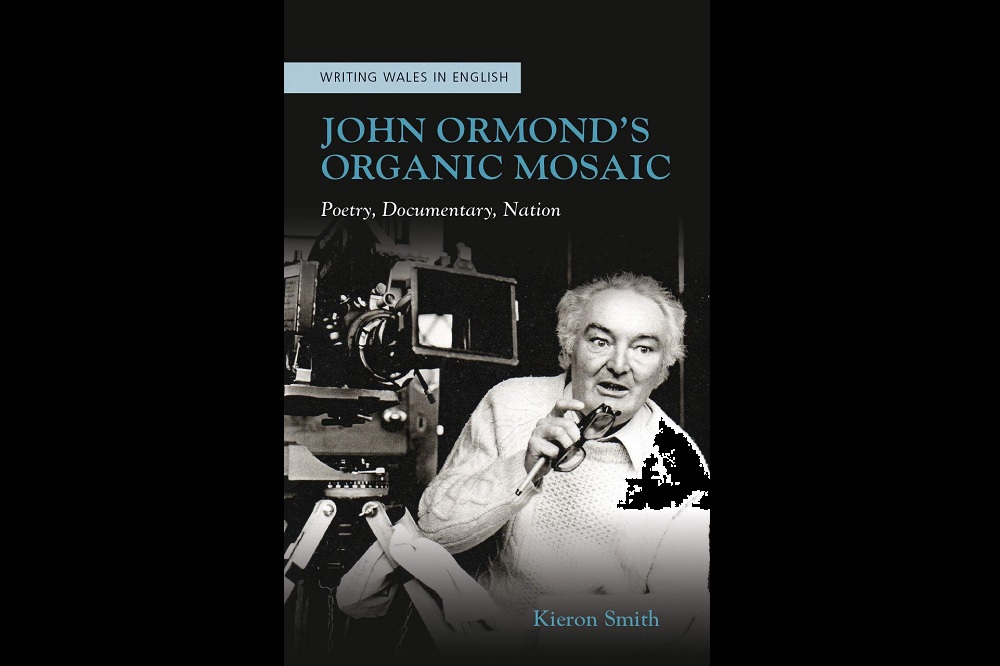Review: John Ormond’s Organic Mosaic is an accessible account of his contribution to Welsh culture

Jon Gower
Craft was one of the keywords in John Ormond’s life, always discernible in his writing and clearly visible in his beautifully searching television films. The fact that his father was a village shoemaker in Dunvant near Swansea had much to do with the son’s lifelong celebration of the skills of making things. It is evidenced in the poem ‘At his Father’s Grave’ where he “remembers his two hands/ his laugh,/his craftsmanship. They are his epitaph.”
It’s there, too, in perhaps Ormond’s most famous poem, ‘Cathedral Builders’ where the account of the construction of a cathedral is as much a celebration of the men who ‘climbed on sketchy ladders towards God/with winch and pulley hoisted hewn rock into heaven’ as it is the building’s lofty arches and inner space.
As Smith reminds us Ormond was a journalist too, and his time on the ‘Picture Post’ gave him valuable experience of matching words to image. His stint as a sub-editor on the South Wales Evening Post, where he imagined he would be better able to write poetry in his spare time, was less successful. Here he found himself writing a line of verse at night and then counting the number of letters in it, as he would in his day job. But it was also the time when he wrote the fabulous three-line headline ‘Swansea Man/ Weds Swansea Woman/ In Swansea.’
Ormond was extremely lucky to start his career at the BBC when documentary film-making was still in its infancy, even though pioneers such as John Grierson had already found boundaries at which to push. The Reithian philosophy of the corporation at the time, that programmes had to inform, educate and entertain allowed documentaries to be informational but poetic too.
When Ormond joined the Beeb staff he had zero experience and yet his love of art – nurtured, as a schoolboy, by visits to the Glynn Vivian art gallery in Swansea and, at university, by mitching off lectures to go to drawing classes at the local art school – stood him in good stead. Indeed he once claimed that he had a ‘heightened sense of seeing and looking and gazing’.
This sense informed a fine body and very substantial body of films, numbering fifty in all, which complemented a corpus of 140 poems in what Smith describes as an ‘illustrious, and fruitfully dualistic, creative career’. As he says ‘the two forms were in continuous correspondence with another throughout Osmond’s creative life.’
Remarkable
His best film work stands with the most memorable and moving depictions of life in Wales, not least his haunting portrait of two Polish refugee brothers, Eugenius Okolowicz and Vlodek Bulaj, struggling desperately to make a poor living on a remote farm in Carmarthenshire. With narration by Richard Burton the film left members of the TV audience ‘touched and humbled’ and underlined the deep humanity of Ormond’s portrayal of the men’s struggles with broken tractors and the unyielding earth. Life’s unfairness is most bitterly felt in the pain of Bulaj missing his daughter’s wedding back in Poland. Sometimes Ormond wrote poems for which the touchstone would be the TV film he had just made. Ormond’s wife Glenys suggested he might write a poem about the two brothers at Penygaer farm because ‘the subject has so moved him.’ Tellingly, he replied ‘No, that film was the poem.’
Ormond also made a suite of portraits of fellow artists, such as Kyffin Williams, Josef Herman and Ceri Richards and writers such as Alun Lewis, Dylan Thomas and R.S.Thomas as well as producing history series. Kieron Smith is particularly good at setting these in the context of BBC and more general broadcasting history and also Welsh historiography, not least the way the latter found expression on the small screen.
Smith, for instance, notes the arrival of a BBC style manual, ‘Principles and Practise in Documentary Programmes’ which some of the free spirits must have found stifling, presaging the arrival of outside consultants such as McKinsey and Co who ushered in a period of stringent financial discipline and management overhaul.
John Ormond’s Organic Mosaic is a timely book as it serves to remind us of the considerable contribution of a fine poet and poetic film-maker to Welsh culture, at a time when programmes about a country were also important in shaping a nation’s sense of itself, as well as informing the rest of Britain of our existence. In this, the programmes made by Ormond to accompany the investiture of Prince Charles in 1969 and broadcast on BBC 2 acted as an ‘intensive course in Welshness.’.
Some of John Ormond’s TV work also took him out of Wales, significantly to Patagonia, where his programmes commemorated the centenary of the emigrants sailing there on the Mimosa and to Tuscany, where his documentary about a local choir in Arezzo preparing to compete in the Llangollen International Eisteddfod found commonalities between Wales and the birthplace of Michelangelo, Vasari and Petrarch.
Reading this scholarly but accessible account of Ormond’s life is akin to leaving a cathedral and pausing to look up, as did the builder in that poem of John’s, who ‘cocked a squint eye aloft and said “I bloody did that.”’ Ormond did too, building a remarkable body of work that invites and rewards close scrutiny such as Kieron Smith’s, which hopefully, in turn, will send us back to the films and the poems. After all, writing poetry, for Ormond started as he put it himself, in ‘a sensual delight in building, out of words, shapes to be spoken’.
John Ormond’s Organic Mosainc: Poetry, Documentary, Nation by Kieron Smith is published by University of Wales Press and can be bought here.
Support our Nation today
For the price of a cup of coffee a month you can help us create an independent, not-for-profit, national news service for the people of Wales, by the people of Wales.





